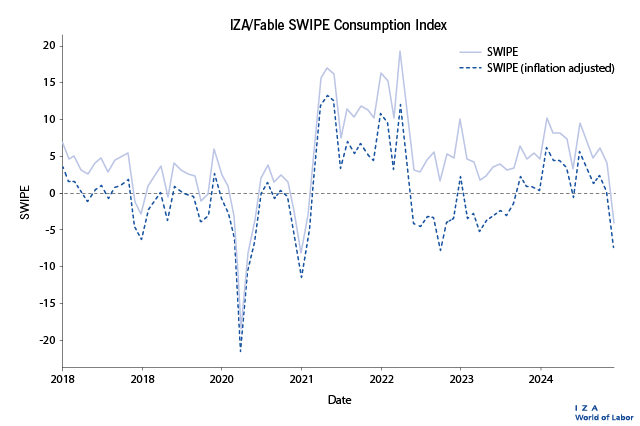
New tools like the SWIPE index can deliver valuable insights that drive better decision-making and avoid missteps in managing public expectations
As scientists—whether empirical economists or data analysts—we rely on data to understand and nowcast the world. This evidence-based approach stands in sharp contrast to the irrational denialism that dismisses established facts, such as climate change or the benefits of vaccination. Such attitudes are not just fringe beliefs; they have tangible consequences, influencing public policies and health outcomes in ways that can undermine societal well-being. This alarming tendency to disregard evidence underscores the critical need for accurate, timely, and objective data in decision-making and highlights the importance of our work.
Understanding the world in real time is essential for crafting optimized policy responses to emerging trends. Failure to do so can have significant consequences, particularly when the economy reacts to its own forecasts. Unlike weather, which remains unaffected by predictions, economic expectations can become self-fulfilling. For instance, announcing an unwarranted downturn during a period of structural challenges, geopolitical instability, and macroeconomic uncertainty could amplify negative consumer sentiment and trigger the very recession that might otherwise not have occurred.
In September 2024 we released the IZA/Fable SWIPE Consumption Index for Germany, a new transactions-based indicator, to complement existing survey-based sentiment measures. Unlike subjective indicators, which reflect perceptions, the SWIPE index offers an objective, fact-driven alternative. By providing timely and nuanced assessments of breaking consumption trends, it strengthens our ability to make informed decisions. This is akin to seeking a second opinion when faced with a grim diagnosis from your doctor: combining insights from multiple approaches provides a clearer, more reliable picture and reduces the risk of acting on potentially flawed information.
From a mathematical perspective, using multiple methods to forecast the same variable enhances precision. The mean of multiple predictions, as can easily be seen by elementary means i.e. the triangle inequality, has a smaller absolute error than any single prediction. For data scientists, this underscores the importance of adding as many timely and diverse readings as possible to reduce biases and improve reliability.
Every method has its own assumptions and limitations, but averaging offsets these constraints. For example, the November reading of our SWIPE index initially indicated a year-on-year consumption growth of slightly over 6%, based on early November 2024 transactions. With more incoming data this figure later stabilized at slightly over 4%, reflecting the timing of Black Friday—which fell on November 29 in 2024 compared to November 24 in 2023. As a result, some spending, such as Cyber Monday (December 2 in 2024, versus November 27 in 2023), contributed to a strong 9.9% year-over-year increase of the 14-day month-to-date comparison. With more comprehensive, close to complete, data for the month we finally see a -3.3% year-over-year decline, suggesting that the recent negative consumer sentiment readings may have materialized in reduced consumer spending in December 2024.
Such nuances highlight the need for precision in both understanding and communicating economic trends. By leveraging tools like the SWIPE index, we can deliver actionable insighty that drive better decision-making and avoid missteps in managing public expectations. In a world increasingly shaped by complex and fast-moving data, vigilance in our analytical work is not just a virtue—it is a necessity.
© Nikos Askitas
Nikos Askitas is Coordinator of Data and Technology at IZA
Please note:
We recognize that IZA World of Labor articles may prompt discussion and possibly controversy. Opinion pieces, such as the one above, capture ideas and debates concisely, and anchor them with real-world examples. Opinions stated here do not necessarily reflect those of the IZA.
Related IZA World of Labor content:
Big Data in economics by Matthew Harding and Jonathan Hersh
Google search activity data and breaking trends by Nikolaos Askitas
What is the role for molecular genetic data in public policy? by Weili Ding and Steven F. Lehrer
Transparency in empirical economic research by Cristina Blanco-Perez and Abel Brodeur